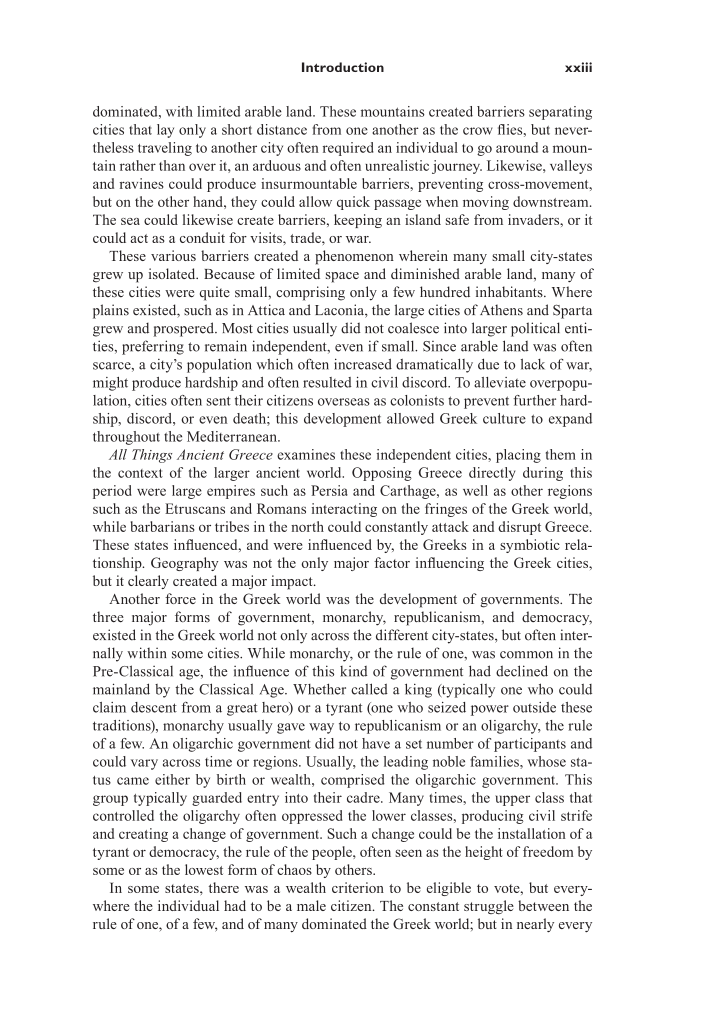Introduction xxiii dominated, with limited arable land. These mountains created barriers separating cities that lay only a short distance from one another as the crow flies, but never- theless traveling to another city often required an individual to go around a moun- tain rather than over it, an arduous and often unrealistic journey. Likewise, valleys and ravines could produce insurmountable barriers, preventing cross-movement, but on the other hand, they could allow quick passage when moving downstream. The sea could likewise create barriers, keeping an island safe from invaders, or it could act as a conduit for visits, trade, or war. These various barriers created a phenomenon wherein many small city-states grew up isolated. Because of limited space and diminished arable land, many of these cities were quite small, comprising only a few hundred inhabitants. Where plains existed, such as in Attica and Laconia, the large cities of Athens and Sparta grew and prospered. Most cities usually did not coalesce into larger political enti- ties, preferring to remain independent, even if small. Since arable land was often scarce, a city’s population which often increased dramatically due to lack of war, might produce hardship and often resulted in civil discord. To alleviate overpopu- lation, cities often sent their citizens overseas as colonists to prevent further hard- ship, discord, or even death this development allowed Greek culture to expand throughout the Mediterranean. All Things Ancient Greece examines these independent cities, placing them in the context of the larger ancient world. Opposing Greece directly during this period were large empires such as Persia and Carthage, as well as other regions such as the Etruscans and Romans interacting on the fringes of the Greek world, while barbarians or tribes in the north could constantly attack and disrupt Greece. These states influenced, and were influenced by, the Greeks in a symbiotic rela- tionship. Geography was not the only major factor influencing the Greek cities, but it clearly created a major impact. Another force in the Greek world was the development of governments. The three major forms of government, monarchy, republicanism, and democracy, existed in the Greek world not only across the different city-states, but often inter- nally within some cities. While monarchy, or the rule of one, was common in the Pre-Classical age, the influence of this kind of government had declined on the mainland by the Classical Age. Whether called a king (typically one who could claim descent from a great hero) or a tyrant (one who seized power outside these traditions), monarchy usually gave way to republicanism or an oligarchy, the rule of a few. An oligarchic government did not have a set number of participants and could vary across time or regions. Usually, the leading noble families, whose sta- tus came either by birth or wealth, comprised the oligarchic government. This group typically guarded entry into their cadre. Many times, the upper class that controlled the oligarchy often oppressed the lower classes, producing civil strife and creating a change of government. Such a change could be the installation of a tyrant or democracy, the rule of the people, often seen as the height of freedom by some or as the lowest form of chaos by others. In some states, there was a wealth criterion to be eligible to vote, but every- where the individual had to be a male citizen. The constant struggle between the rule of one, of a few, and of many dominated the Greek world but in nearly every
Document Details My Account Print multiple pages
Print
You have printed 0 times in the last 24 hours.
Your print count will reset on at .
You may print 0 more time(s) before then.
You may print a maximum of 0 pages at a time.

































































































































































































































































































































































































































































































































































































































































